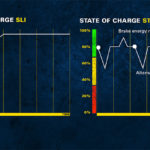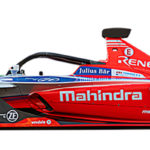It seems “obvious” that starting and stopping a car’s engine repeatedly adds to stresses on the mechanical components and therefore shortens the life of the power train. But does it? The answer is “yes and no.” This part explores some of the underlying issues.
Q: How many stop/start cycles are we looking at?
A: Numbers vary, but one knowledgeable expert says this: “A normal car without automatic stop-start can be expected to go through up to 50,000 stop-start events during its lifetime,” according to Gerhard Arnold, who is responsible for bearing design at Federal-Mogul. “But with automatic stop-start being activated every time the car comes to a standstill, the figure rises dramatically, perhaps to as many as 500,000 stop-start cycles over the engine’s life.” Others say that the stop/start estimate is low by a factor of two to five times.
Q: What are some issues related to engine wear?
A: Consider the crankshaft: It’s supported by precision-ground journals along its length running in ‘plain’ main bearings (meaning there are no ball bearings or rollers, just smooth metal). The part of the crankshaft at the back of the engine, immediately adjacent to the starter motor, endures the highest loading.
Q: How does stop/start operation change that situation?
A: When the engine is running, the crankshaft and main bearing surfaces don’t actually touch, but are separated by a super-thin film of oil which fed under pressure (called ‘hydrodynamic lubrication’) and pumped throughout the bearing surfaces by the spinning crankshaft. However, when the engine stops, the crank settles onto the bearing with the two metal surfaces coming into contact. Then when the engine is started, there’s a short period before the two surfaces become separated by that oil film (a situation called the ‘boundary condition’) where the crankshaft is spinning, but there’s direct metal-to-metal contact between the bearing surfaces. This is when most wear takes place and having so many stop/start cycles can lead to early failure.
Q: How is the negative impact of metal-metal contact overcome?
A: It requires improvements in both materials and lubrication technologies. Bearing manufacturers are developing new materials with greater self-lubricating properties to resist wear on start-up. For example, Federal-Mogul developed a proprietary metal called Irox with a polymer coating containing particles of iron oxide – yes, rust – which in microscopic form is surprisingly slippery. The coefficient of friction of an Irox bearing is 50 percent lower than a conventional aluminum bearing and should last the life of an engine equipped with stop-start. On the lubrication side, the modern engine oil with its complex chemical composition is being improved with even lower-friction, longer-lasting formulations.
Q: What about the starter motor itself?
A: It’s not enough to simply make the stater “more rugged” as this brings new design tradeoffs, adds weight and cost, and is only a partial solution. Instead, it requires making many small changes, including:
- The gear ratio from the starter-drive pinion to the flywheel ring gear is optimized to make the starter’s motor turn more slowly. This reduces starter-motor RPM since 90 percent of starter-motor brush wear occurs not during cranking, but during the coast-down after the start has finished. If a higher-torque motor can spin more slowly, its coast-down time is shorter, thus increasing its longevity.
- The composition of the carbon and copper brushes on a start-stop motor differs from its traditional counterparts, in order to increase longevity without accelerating the wear on the commutator.
- Rather than rely on oil-impregnated bushings for the rotating assemblies, stop/start starters mostly use needle bearings.
- Stop/start motors are integrated with other technologies that identify when each piston of the cylinders of the engine will reach the top-dead-center. In this way, the starter can be revved up to full speed and engaged at the optimum point in the piston position. It does this by allowing the fuel injectors to pulse and fire during the middle of a complete rotation of the crank, rather than having to wait for a complete revolution that lets the first cylinder reach that position to start the fuel-spark timing sequence.
(Note that Mazda announced a system in 2009 that does not need a starter to restart but uses fuel injection and an ignition spark in one of the cylinders at the optimum point, but it not clear if this was ever actually used in a production vehicle.)
The above changes are not obvious or very visible, in the normal sense, but one other change is very apparent:
- In contrast to the non-stop/start starter, the solenoid on stop/start starters decouples the mechanical action of engaging the drive pinion into the flywheel from the electrical action of stopping and starting the motor. This is done by using two individually controlled relays and solenoids to allow for smooth engagement of the pinion gear into the flywheel with minimum noise and wear, rather than the single relay plus solenoid of a non-stop/start system, (Figure 1) and (Figure 2).


other to energize the starter motor itself. (Image: GM TechLink)
This dual- or tandem-solenoid arrangement enables to starter to turn the power on and off to the motor, optimizing contact design and wear, against contacts that have to be integrated as part of a spring-loaded plunger. It also reduces the electrical load requires to turn the engine, so that there is enough current available for accessories and lighting to operate during the start event.
Clearly, adding stop/start is not trivial from a mechanical-engineering perspective. It is also complicated from an electronic circuit and algorithm perspective, which we will explore in Part 5.
Related EE World Content
Are power systems up to the task of running self-driving cars?
Power modules lessen the load on internal combustion engines
Today in Engineering History: Internal Combustion Engine Patented
Hybrid EVs come to touring car racing
How bidirectional converters speed the design of dual-battery automotive systems
External References
There’s a lot of information available about stop/start, as there is for almost anything related to cars: it’s a big industry that affects just about everyone in one way or another. Perhaps because stop/start is relatively new, contrary to tradition, and has many technical and driver-related issues, the content of these sites ranges from personal opinion to technical discussion, to in-depth technical analysis. These are the useful sites and sources I reviewed for this article:
- Green Car Reports, “Don’t start-stop systems wear out your car’s starter?”
- Autocar, “Stop-start systems: is there a long-term impact on my car’s engine?”
- CarPro USA, “Understanding Stop/start Systems”
- Driving, “How It Works: Starters and automatic start-stop technology”
- Varta (Clarios), “Reasons why the start-stop system does not work”
- Varta (Clarios), “What is automatic start-stop and how does it work?”
- Varta (Clarios), “Why do I need a special battery for the automatic start-stop system?”
- Varta (Clarios), “Start-Stop”
- The Jag Wrangler, “SmartStartStop”
- The Truth About Cars, “The Problem With Start-Stop Systems”
- Best Ride, “Does Auto-Stop/Start Technology Wear Out Engine Components?”
- Practical Motoring, “Myth-busting: Does stop-start damage your engine?”
- NAPA, “Stop-Start Technology — Pros and Cons”
- Idle Smart, “Pros and Cons of Automatic Engine Stop/start Solutions”
- How Stuff Works, “Love It or Hate It: Stop-start Technology Is Here to Stay”
- Wikipedia, “Start-stop system”
- STMicroelectronics, “48V Start-Stop System”
- Daimler, “Under the microscope: ECO stop/start: Sophisticated technology gives the highest levels of efficiency”
- Argonne National Laboratory, “Start and Restart Effects on Modern Vehicle Starting Components”
- Bosch, “Full power for stop/start”
- How a Car Works, “How the starting system works”
- Your Mechanic, “How Does a Starter Motor Work?”
- General Motors, “Cadillac’s Electric Self Starter Turns 100”
- Elreg Distributors, “The Evolution of the Starter Motor”
- PR Newswire, “ZMJ and CRCI to Acquire Bosch’s Starters and Generators Business”
- TechLink, “Enhanced Starter Motor Operation in Engine Stop/Start Systems”
- JeepFan, “How Electronic Start Stop ESS Works on the Jeep Wrangler JL”
- Autoblog/Verizon Media, “Mazda introduces clever start-stop system with direct injection”







Leave a Reply